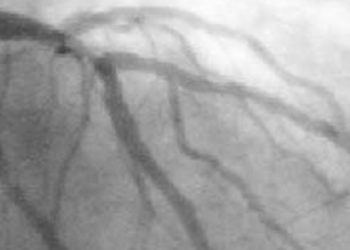2 Minute Medicine Rewind February 17, 2025
Meconium-Related Obstruction and Clinical Outcomes in Term and Preterm Infants
1. Nearly 95% of cases of meconium-related obstruction (MRO) occur in the absence of cystic fibrosis or Hirschsprung disease
2. MRO occurred most frequently in preterm infants, who more often experienced longer hospital stays and required surgical intervention
Evidence Rating Level: 2 (Good)
Historically, the causes of most cases of meconium ileus and meconium plug syndrome have been attributed to cystic fibrosis and Hirschsprung disease, respectively. However, there is limited data reporting on the modern epidemiology of MRO. This retrospective cohort study therefore sought to investigate the incidence of MRO in infants and the underlying rates of prematurity, cystic fibrosis and Hirschsprung disease among these infants. 3,550,796 neonates (51.2% male) from the National Inpatient Sample Healthcare Cost and Utilization Project in the United States were identified. Outcomes of interest included the diagnosis of MRO associated with cystic fibrosis, Hirschsprung disease or neither, as well as associated clinical outcomes. Among the total study cohort, 1844 (0.1%) neonates were diagnosed with MRO. 41 (2.2%) of these neonates had concomitant cystic fibrosis while 60 (3.3%) had Hirschsprung disease, and 1743 (94.5%) had neither. Factors associated with a higher risk of developing MRO in neonates with MRO compared to unaffected neonates included preterm birth (634 [34.4%] vs 321 865 [9.1%]; P < .001), low birth weight (463 [25.1%] vs 229 908 [6.5%]; P < .001), and small for gestational age (150 [8.1%] vs 141 896 [4.0%]; P < .001). MRO of prematurity was associated with an increase in the length of hospitalization of 7.3 days (95% CI, 5.8-8.8 days; 48.0% relative change) and an increase in the likelihood of requiring abdominal surgery of 4.2% (95% CI, 3.1-5.4 percentage points; 1400.0% relative change). Overall, this study found that 94.5% of cases of MRO occur in the absence of cystic fibrosis or Hirschsprung disease, and that MRO occurred most commonly among preterm infants without either condition.
Intraoperative Esketamine and Postpartum Depression Among Women With Cesarean Delivery
1. Intraoperative esketamine infusion significantly reduced the incidence of postpartum depression (PPD) at 6 weeks post partum in women undergoing cesarean delivery.
Evidence Rating Level: 1 (Excellent)
PPD, which affects nearly 18% of women after delivery globally and can have major impacts on parent-child bonding, is more likely to affect women who undergo cesarean delivery compared to vaginal delivery. Past randomized controlled trials (RCTs) have explored the effects of esketamine on PPD in women who have undergone cesaraean delivery, but these RCTs have had conflicting results. This single-centre, double-blind pragmatic trial therefore sought to investigate the efficacy of esketamine on preventing PPD in women undergoing cesarean delivery. 308 patients from Chongqing, China were assigned to receive either esketamine infusion intraoperatively (n = 154; mean [SD] patient age, 31.57 [4.26] years) or to a control group (n = 154; mean [SD] patient age, 32.53 [7.74] years). The primary outcome of interest was the incidence of PPD 6 weeks post partum as assessed by the Edinburgh Postnatal Depression Score (EPDS). At 6 weeks post partum, the incidence of PPD was significantly lower in the esketamine group compared to the control group (10.4% [16] vs 19.5% [30]; RR, 0.53; 95% CI, 0.30-0.93; P = .02). Adverse events occurred more frequently in the esketamine group compared to the control group, such as dizziness (28 [18.2%] vs 3 [1.9%]; χ2 = 22.41; P < .001). Overall, this study found that intraoperative esketamine infusion significantly reduced the incidence of PPD at 6 weeks in women undergoing cesarean delivery.
1. The use of high flow nasal cannula (HFNC) in patients with obesity undergoing sedated gastrointestinal endoscopy significantly reduced the incidence of hypoxia and subclinical respiratory depression.
Evidence Rating Level: 1 (Excellent)
Hypoxia is the most common adverse event occurring during gastrointestinal endoscopy. Patients with obesity are at an increased risk of hypoxemia owing to several factors such as poor lung and chest wall compliance. This multicentre, randomized, parallel group trial therefore sought to investigate the effects of HFNC in patients with obesity undergoing sedated gastrointestinal endoscopy. 984 patients from three different hospitals in Shanghai, China were included for analysis with 487 (mean[SD] age, 48.6[12.8] years; 62.2% male) randomized to received regular nasal oxygen and 497 (mean[SD] age, 49.9[13.2] years; 64.1% male) randomized to receive HFNC. The primary study endpoint was the incidence of hypoxia, with secondary study endpoints including the incidences of subclinical respiratory depression and severe hypoxia. The incidence of hypoxia was significantly lower in the HFNC group (2.0% vs 21.2%; risk ratio 0.10, 95% confidence interval (CI) 0.04 to 0.18; P<0.001). Similarly, the rates of subclinical respiratory depression were 5.6% and 36.3% in the HFNC and control groups respectively (risk ratio 0.16, 95% CI 0.10 to 0.22; P<0.001). Overall, this study found that the use of HFNC in patients with obesity undergoing sedated gastrointestinal endoscopy significantly reduced the incidence of hypoxia and subclinical respiratory depression.
1. The use of contemporary hormonal contraceptives was associated with an increased risk of ischemic stroke and myocardial infarction.
Evidence Rating Level: 2 (Good)
Some evidence has suggested that the use of hormonal contraception is associated with an increased risk of ischemic stroke and myocardial infarction, but results are inconsistent across different studies. This nationwide, prospective cohort study therefore sought to investigate the association between contemporary hormonal contraceptive use and risk of incident ischemic stroke and myocardial infarction based on type of contraceptive and mode of administration. 2,025,691 Danish women between the ages of 15 and 49 received follow-up between January 1996 until July 2021. Compared to no use of hormonal contraception, use of oral contraceptives containing estrogen and progestin was associated with an adjusted incidence ratio of 2.0 (95% confidence interval (CI) 1.9 to 2.2) for ischaemic stroke and 2.0 (1.7 to 2.2) for myocardial infarction. The use of combined non-oral contraceptives was associated with an adjusted incidence rate ratio of 2.4 (95% CI 1.5 to 3.7) for ischaemic stroke and 3.8 (2.0 to 7.3) for myocardial infarction when compared to no use of hormonal contraception. Compared to no use of hormonal contraception, the use of progestin-only oral contraceptives was associated with adjusted incidence rate ratios of 1.6 (95% CI 1.3 to 2.0) for ischaemic stroke and 1.5 (1.1 to 2.1) for myocardial infarction. The use of progestin-only non-oral contraceptives was associated with an adjusted incidence rate ratio of 2.1 (95% CI 1.2 to 3.8) for ischemic stroke and 1.8 (0.8 to 4.4) for myocardial infarction compared with no use of hormonal contraception. Overall, this study found that the use of contemporary hormonal contraceptives was associated with an increased risk of ischemic stroke and myocardial infarction.
1. Use of the semi-blunt dissection technique with endoscopic resection of gastric submucosal tumours was associated with a smaller maximum diameter of gastric muscularis propria damage and a shorter postoperative hospital stay.
Evidence Rating Level: 2 (Good)
In recent years, endoscopic resection has increasingly been used for the resection of gastric submucosal tumours (SMTs). No studies have compared the treatment efficacy of conventional methods with semi-blunt dissection. This single-centre, retrospective study therefore sought to compare the safety and efficacy of semi-blunt dissection in the resection of gastric SMTs with the conventional method. 113 patients at the Peking University People’s Hospital who underwent endoscopic resection of gastric SMTs originating in the muscularis propria were retrospectively analyzed, with 73 receiving the conventional method and 40 receiving semi-blunt dissection. The maximum diameter of gastric muscularis propria damage was significantly greater among those who received the conventional method compared to those who received semi-blunt dissection (1.06 ± 0.48 cm vs. 0.46 ± 0.09 cm, p < 0.001). The length of hospitalization postoperatively was significantly shorter in those receiving semi-blunt dissection compared to those receiving the conventional method (7.66 ± 2.90 days vs. 5.80 ± 1.96 days, p < 0.001). There was no significant difference in the percentage of histologically confirmed positive resection margins. Overall, this study found that the use of semi-blunt dissection in the resection of gastric SMTs was associated with reduced damage to the gastric muscularis propria and a shorter postoperative hospital stay.
Image: PD
©2025 2 Minute Medicine, Inc. All rights reserved. No works may be reproduced without expressed written consent from 2 Minute Medicine, Inc. Inquire about licensing here. No article should be construed as medical advice and is not intended as such by the authors or by 2 Minute Medicine, Inc.







